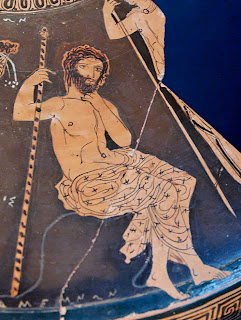The descendents of Tantalos via Pelops lead directly to Homeric epic and Greek tragedy.
Here's how Homer traces the line of Pelops through the sceptre of Agamemnon, (Iliad 2. 100 ff trans. Lattimore):
Powerful Agamemnon stood up holding the sceptre Hephaistos had wrought him carefully. Hephaistos gave it to Zeus the king, the son of Kronos, and Zeus in turn gave it to the courier Argeiphontes, and lord Hermes gave it to Pelops, driver of horses, and Pelops again gave it to Atreus, the shepherd of the people. Atreus dying left it to Thyetes of the rich flocks, and Thyestes left it in turn to Agamemnon to carry and to be lord of many islands and over all Argos.According to Theoi, the sceptre was the ancient Greek equivalent of the crown, symbol of kingship. Atreus and Thyestes are here understood to be the sons of Pelops, as in later accounts.
According to Pausanias, the sceptre was the only work of Hephaistos considered authentic in the ancient world:
Poets have sung, and the tradition of men has followed them, that Hephaistos made many works of art, but none is authentic except only the scepter of Agamemnon. Description of Greece 9. 41. 1 (trans. Jones) (Greek travelogue C 2nd A.D.)

Agamemnon holding his sceptre, 400 B.C.

No comments:
Post a Comment